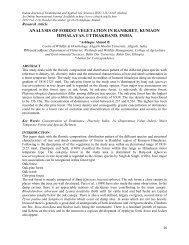in vitro propagation of rhododendron niveum hook f (state ... - CIBTech
in vitro propagation of rhododendron niveum hook f (state ... - CIBTech
in vitro propagation of rhododendron niveum hook f (state ... - CIBTech
You also want an ePaper? Increase the reach of your titles
YUMPU automatically turns print PDFs into web optimized ePapers that Google loves.
Cibtech Journal <strong>of</strong> Biotechnology ISSN: 2319-3859 (Onl<strong>in</strong>e)<br />
An Onl<strong>in</strong>e International Journal Available at http://www.cibtech.org/cjb.htm<br />
2013 Vol. 2 (1) January-March., pp.53-60/S<strong>in</strong>gh et al.<br />
Research Article<br />
concentration <strong>of</strong> NAA. In the treatments <strong>of</strong> NAA, the <strong>in</strong>duced roots were short and thick. On the<br />
other hand, <strong>in</strong> the treatments <strong>of</strong> IBA, the <strong>in</strong>duced roots were long and th<strong>in</strong> Accord<strong>in</strong>g to Jutta (2000)<br />
transport velocity <strong>of</strong> IBA was markedly slower as compared to other growth regulators.<br />
Table 2: Effect <strong>of</strong> different concentrations <strong>of</strong> various plant growth regulators on shoot regeneration<br />
Regeneration<br />
Mean number <strong>of</strong> shoots/explants Mean shoot length (cm)<br />
(%)<br />
BA (5 mg/l) 3.00 ± 0.33 4.60 ± 0.25<br />
BA (5 mg/l)<br />
4.00 ± 0.33 5.60 ± 0.35<br />
+IAA (0.1 mg/l)<br />
KIN (5mg/l) 4.75 ± 0.33 3.76 ± 0.36<br />
KIN (5mg/l)<br />
5.50± 0.57 3.90 ± 0.06<br />
+IAA (0.1 mg/l)<br />
2-iP (5mg/l) 8.75 ± 0.57 7.10 ± 0.58<br />
2-iP (5mg/l)<br />
9.00± 0.33 7.73± 0.23<br />
+IAA (0.1 mg/l)<br />
LSD at the 5% level 3.5 5.27<br />
Values represent means ±SE. Each treatment consisted <strong>of</strong> 10 replicates and the experiment was repeated<br />
twice. Data were recorded after 8 weeks <strong>of</strong> culture.<br />
Higher concentration <strong>of</strong> aux<strong>in</strong> lowered the root<strong>in</strong>g percentage as well as root number. Data on percentage<br />
<strong>of</strong> root<strong>in</strong>g and mean number <strong>of</strong> roots per shoot were recorded after 6 weeks <strong>of</strong> transfer. Plantlets with<br />
good developed leaves and root were washed with sterile distilled water and dipped with systemic<br />
fungicides (Bavist<strong>in</strong>, 0.15%, w/v, 20 m<strong>in</strong>s) to m<strong>in</strong>imise pathogen attack and planted <strong>in</strong> plastic pots<br />
conta<strong>in</strong><strong>in</strong>g fresh peat moss and soil (1:3). Plantlets were <strong>in</strong>itially ma<strong>in</strong>ta<strong>in</strong>ed under culture room<br />
(17±1 °C) conditions for five weeks (Figure 1F,G). The micropropagated plants, follow<strong>in</strong>g harden<strong>in</strong>g and<br />
establishment <strong>in</strong> the greenhouse were transferred to the field at Arboretum <strong>of</strong> the Institute (Figure H). The<br />
transplanted plantlets established well <strong>in</strong> pots and <strong>in</strong> the field. The <strong>in</strong> <strong>vitro</strong> regeneration <strong>of</strong> shoots, root<strong>in</strong>g<br />
and soil establishment protocol <strong>in</strong> this study suggests that there is possibility <strong>of</strong> adopt<strong>in</strong>g tissue culture<br />
techniques for mass <strong>propagation</strong> <strong>of</strong> <strong>rhododendron</strong> spp. Consider<strong>in</strong>g the status <strong>of</strong> this species <strong>in</strong> terms <strong>of</strong><br />
57
















